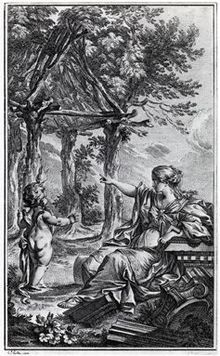Marc-Antoine Laugier
This article needs additional citations for verification. (May 2014) |
Marc-Antoine Laugier | |
|---|---|
| Born | January 22, 1713 |
| Died | 5 April 1769 (aged 55–56) |
| Notable work | Essay on Architecture |
Main interests | History, Architecture |
Marc-Antoine Laugier (Manosque, Provence, January 22, 1713 – Paris, April 5, 1769) was a Jesuit priest until 1755, then a Benedictine monk. Overlooking Claude Perrault and numerous other figures, Summerson notes,
Marc Antoine Laugier can perhaps be called the first modern architectural philosopher.
Laugier is best known for his Essay on Architecture published in 1753.[1] In 1755 he published the second edition with a famous, often reproduced illustration of a primitive hut. His approach is to discuss some familiar aspects of Renaissance and post-Renaissance architectural practice, which he describes as 'faults'. These 'faults' induce his commentary on columns, the entablature, and on pediments.

Among faults he lists for columns are that of "being engaged in the wall", the use of pilasters, incorrect entasis (swelling of the column), and setting columns on pedestals. Being embedded in the wall detracts from the overall beauty and aesthetic nature of columns; Laugier states that columns should be free. He goes on to assert that the use of pilasters should strictly be frowned upon especially since in nearly every case columns could be used instead. The second fault is created by incorrect proportion, and the last he believes is more of an unintelligible design. Resting columns on pedestals, he says, is like adding a second set of legs beneath the first pair.
The Essai sur l'architecture includes his thoughts on several other topics, ranging from solidity, the different orders, and how to construct different buildings.
With the collaboration of the journalist and theatre historian Antoine de Léris and Antoine Jacques Labbet, abbé de Morambert, he edited the first French review of music,[2] Sentiment d'un harmonophile sur différents ouvrages de musique ("Amsterdam", i.e. Paris:Jombert, 1756).[3]
Notes
[edit]- ^ The standard discussion in English is Wolfgang Herrmann, Laugier and Eighteenth-Century French Theory (London 1962).
- ^ Das erste in Frankreigh veröffentlichte Musik-Journal (Wilhelm Freystätter, Die musikalischen zeitschriften seit ihrer entstehung bis zur gegenwart 1884:15f).
- ^ Noted in Max Graf, Composer and critic: two hundred years of musical criticism, 1946:164, and in Caroline Wood and Graham Sadler, French Baroque opera: a reader 2000:117; Sentiment d'un harmonophile was reprinted, Geneva:Minkoff, 1972.
- Claus Bernet (2003). "Marc-Antoine Laugier". In Bautz, Traugott (ed.). Biographisch-Bibliographisches Kirchenlexikon (BBKL) (in German). Vol. 21. Nordhausen: Bautz. cols. 786–793. ISBN 3-88309-110-3.
